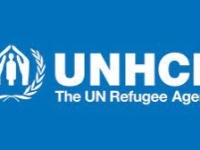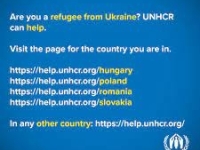Politics
ACCORDING TO UNHCR 368,000 CIVILIANSCROSSED BORDER COUNTRIES FLEEING HOSTILITIES
D-4 OF WAR IN UKRAINE 27 FEBRUARY 2022

Refugees Fleeing Ukraine (Source: TV caption Cnews)
USPA NEWS -
According to UNHCR, at least 368, 000 civilians At least 368,000 people have already crossed into neighbouring countries, fleeing the ongoing hostilities, according to the UN Refugee Agency (UNHCR) as of 7:30 a.m. (CET) on 27 February.
On the European side, the European commissioner in charge of crisis management, Janez Lenarcic, estimates that "seven million Ukrainians will be displaced" in this country because of the Russian offensive. "We are witnessing what could become the biggest humanitarian crisis on our European continent for many, many years." He had explained on Sunday February 27 on an estimate, knowing that since the beginning of the Russian assault, nearly 400,000 Ukrainians had fled the country, towards the European border countries, such as Poland and Romania.
On the European side, the European commissioner in charge of crisis management, Janez Lenarcic, estimates that "seven million Ukrainians will be displaced" in this country because of the Russian offensive. "We are witnessing what could become the biggest humanitarian crisis on our European continent for many, many years." He had explained on Sunday February 27 on an estimate, knowing that since the beginning of the Russian assault, nearly 400,000 Ukrainians had fled the country, towards the European border countries, such as Poland and Romania.
• After three days of intense clashes across certain areas in Ukraine, the number of civilian casualties and damage to critical infrastructure are growing, triggering severe humanitarian consequences on people in the hardest-hit areas. The ongoing hostilities also continue to disrupt local supply chains and access to food and other basic items, hitting the already conflict-stricken areas of Donetska and Luhanska oblasts hardest.?
• At least 376 civilian casualties have been confirmed, including 94 deaths, by the Office of the United Nations High Commissioner for Human Rights (OHCHR) before midnight 26 February. The actual figure could be considerably higher as many reported casualties have yet to be confirmed.?
• At least 368,000 people have already crossed into neighbouring countries, fleeing the ongoing hostilities, according to the UN Refugee Agency (UNHCR) as of 7:30 a.m. (CET) on 27 February.?
• The UN and its humanitarian partners are preparing to rapidly scale-up operations once the security situation permits and mobilize emergency financing to facilitate an effective, broad and timely humanitarian response across all affected areas. Organizations already operating in areas affected by the new wave of hostilities have been able to provide some form of humanitarian assistance.?
• On 1 March, the UN and humanitarian partners will launch a Flash Appeal to address the acute humanitarian needs of crisis-affected people within Ukraine. This appeal is coordinated with the Regional Refugee Response Plan, led by UNHCR.?
SITUATION OVERVIEW
After three days of intense clashes across certain parts of Ukraine, the number of civilian causalities and damage to critical infrastructure are growing, triggering severe humanitarian consequences on people in the hardest-hit areas. Between 24 February and up until midnight 26 February, the OHCHR recorded 376 civilian casualties, with 94 people killed, including seven children; these figures are likely to be considerably higher as many reported casualties have yet to be confirmed.
In the past 24 hours, hostilities have been observed in Chernihiv (north), Kharkiv (north-east), Kherson (south), Kyiv (capital), Mariupol (south-east), Melitopol (south), Mykolaiv (south), Sumy (north) and Zaporizhzhia (south-east), among other areas in the northern, eastern and southern parts of the country.-------------------------------------------------------------------
On the night of 26 February, warnings from municipal authorities of an imminent attack forced people in Kyiv to quickly take shelter, seeking refuge in basements, bomb shelters and underground metro stations across the city of nearly 2.9 million people. Many elderly people and people with disabilities found themselves trapped in the city, due to the challenges of evacuation.
A suspected missile strike hit an oil depot south of the capital in Vasylkiv, setting the facility ablaze and prompting fears of effects of toxic fumes in nearby communities. In Ukraine’s second largest city, Kharkiv, located in the north-east, a gas pipeline was hit. On 26 February, missiles rained down over Kharkiv – home to 1.4 million people – where Russian forces are now reportedly on the streets. Residential areas of the city were also attacked, with at least one woman reportedly killed and dozens evacuated from a multi-storey residential building. In the north-eastern town of Okhtyrka, heavy shelling reportedly killed at least six civilians, including a seven-year-old girl.-------------------------------------------------------------------
This increasingly intense conflict threatens to trigger a humanitarian catastrophe in Ukraine and also in neighbouring countries that are already seeing a massive influx of people fleeing hostilities. At the Ukraine-Poland border, local media outlets report at least 15 km-long lines of people trying to cross. According to the UNHCR, at least 368,000 people have already crossed into neighbouring countries – more than 115,000 have arrived in Poland alone – with millions more expected to flee the country in the coming days.
The ongoing hostilities continue to disrupt local supply chains and access to food and other basic items. In eastern Ukraine, there are reports of food shortages in Kramatorsk (Donetska oblast) as supplies were mostly coming from Kharkiv. Even before 23 February, the escalating tensions in Donetska oblast had already damaged roads and bridges that subsequently limited access to markets for food on the Government-controlled side of the “contact line” for those residing in nonGovernment-controlled areas. Around 400,000 people were already estimated to be severely and moderately food-insecure in eastern Ukraine. Food insecurity is projected to rise considerably, as more and more people are displaced, where access to food, and possibly even supply, will continue to be a challenge. Source: This report is produced by OCHA Ukraine in collaboration with humanitarian partners. It covers the period from 5 p.m. (EET) 26 February 2022 to 5 p.m. (EET) 27 February 2022.
War D-4 Unhcr Fleeing Ukraine Kiev Exodus Poland Romania Sanctions Swift Russian President Putin President Zelenskyy Resistance Kiev Rahma Sophia Rachdi Jedi Foster
Liability for this article lies with the author, who also holds the copyright. Editorial content from USPA may be quoted on other websites as long as the quote comprises no more than 5% of the entire text, is marked as such and the source is named (via hyperlink).








